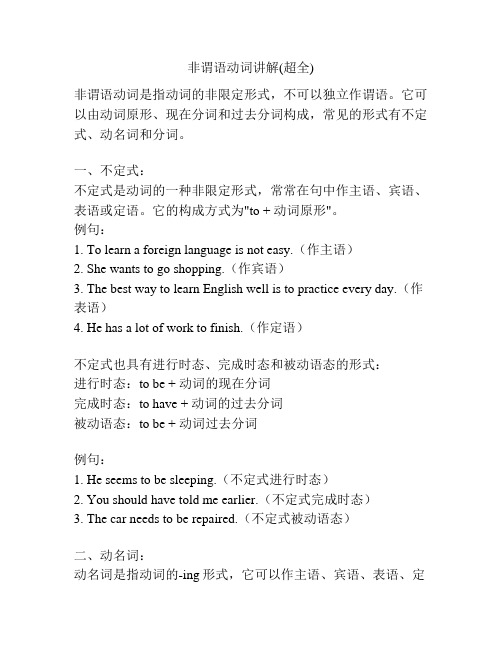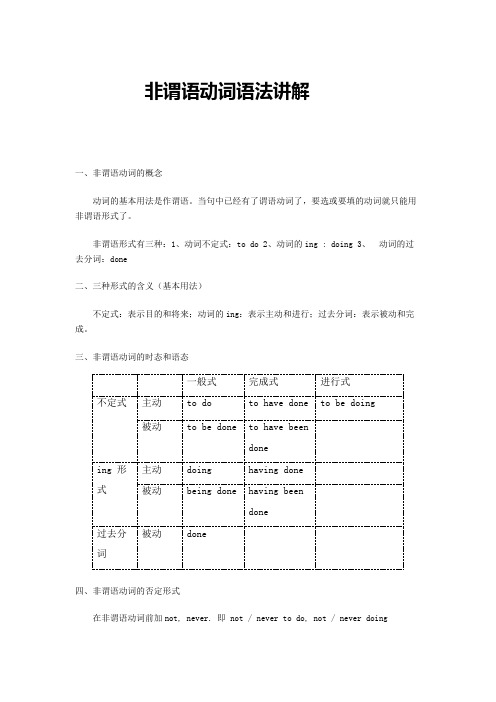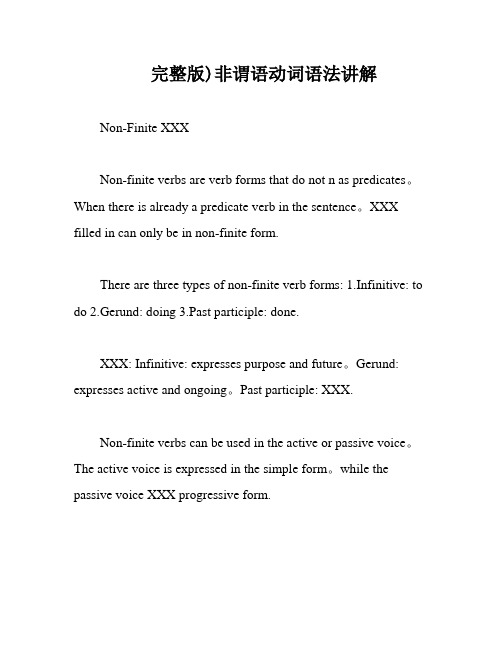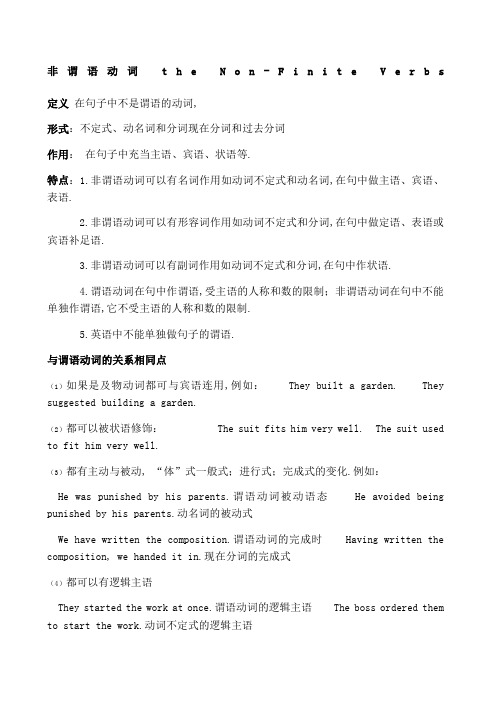(完整版)动词的非谓语动词形式讲解
非谓语动词讲解(超全)

非谓语动词讲解(超全)非谓语动词是指动词的非限定形式,不可以独立作谓语。
它可以由动词原形、现在分词和过去分词构成,常见的形式有不定式、动名词和分词。
一、不定式:不定式是动词的一种非限定形式,常常在句中作主语、宾语、表语或定语。
它的构成方式为"to + 动词原形"。
例句:1. To learn a foreign language is not easy.(作主语)2. She wants to go shopping.(作宾语)3. The best way to learn English well is to practice every day.(作表语)4. He has a lot of work to finish.(作定语)不定式也具有进行时态、完成时态和被动语态的形式:进行时态:to be + 动词的现在分词完成时态:to have + 动词的过去分词被动语态:to be + 动词过去分词例句:1. He seems to be sleeping.(不定式进行时态)2. You should have told me earlier.(不定式完成时态)3. The car needs to be repaired.(不定式被动语态)二、动名词:动名词是指动词的-ing形式,它可以作主语、宾语、表语、定语或状语。
在句中的位置和用法与名词相似。
例句:1. Reading is my favorite hobby.(作主语)2. I enjoy swimming in the summer.(作宾语)3. Her dream is becoming a famous singer.(作表语)4. The girl standing over there is my sister.(作定语)5. He went to the party without saying goodbye.(作状语)动名词与不定式的区别在于动名词具有进行时态和被动语态,而不定式没有。
完整版)非谓语动词归纳总结

完整版)非谓语动词归纳总结非谓语动词归纳总结非谓语动词分为不定式、动名词和分词三种形式。
不定式包括基本形式和完成式,表示将来或发生在谓语动词之前的动作。
动名词和分词则分别表示主动和被动,动名词可用作名词,分词则可用作形容词或副词。
在句子中,非谓语动词常用于表目的、条件和原因等情况下。
例如,“To do”可表示为了某个目的,常带宾语;“Doing/Having done”则表示当某种情况发生时,常带宾语;而“XXX”则表示某种情况已经发生,不带宾语。
需要注意的是,有些情况下使用动词原形,如祈使句中,“Do”后面常用动词原形;而动名词则可作为主语出现,“Doing/Being done”后面可接谓语动词。
例如,仔细看,你就能发现这两张图片的不同之处。
1.Anyone who was seen carrying bags。
boxes。
or cases was XXX(作定语)2.Steam being produced XXX(作主语补足语)3.We decided to stay at home upon seeing the roads covered with snow and ice。
(作宾语补足语)4.The building that will be completed next month will be used as a XXX(作定语)5.The problem being discussed now is not the one that was XXX(作定语)6.XXX(作宾语补足语)7.XXX the air quality in Beijing。
(作目的状语)8.Don't keep the water running when you XXX(作宾语补足语)固定搭配:1.跟不定式作宾语的动词:Aim。
appear。
agree。
arrange。
decide。
choose。
非谓语动词用法精讲(完整版)-(共133张)

● ② 动词-ing形式的完成式一般只用来作状语, 不作定语。两个分词所表示的时间有先后,不 用分词作定语表示先时性。 【误】The temple having been destroyed by the earthquake will be rebuilt soon. 【正】The temple which has been destroyed by the earthquake will be rebuilt soon. 被地 震毁坏的庙宇很快就要重建了。
A. paying B. paid C. to be paid D. being paid
④. The repairs cost a lot ,but it’s money well ________. A.to spend B.Spent C.being spent D.Spending
4、分词作状语
B. hanging
C. hangs
D. being hung
②.Reading is an experience quite different from watching TV; there are pictures _____ in your mind instead of before your eyes.
Do you know anyone having lost a cat? × Do you know anyone who has lost a cat? √
c. 不定式作定语,指将来的时间,与被修饰词 形成主谓、动宾、同位关系或修饰关系。
The next train to arrive was from New York. This is the material ___ in the lab tomorrow.
非谓语动词讲解(超全)

非谓语动词非谓语动词: a.动词不定式 b.动名词 c.分词( 现在分词过去分词)概述:1.谓语动词:在句子中担任谓语的动词2.非谓语动词:是动词的特殊形式,在句中可以作除谓语外的所有成分指出下列句子中非谓语动词的成分1,To see is to believe. 2, It is right to give up smoking.3, He wanted to go 4, I find it interesting to study English.5, He asked me to do the work with him. 6, I have some books for you to read.7, I came here to see you. 8, We were very excited to hear the news.9,Laying eggs is the ant queen’s full-time job. 10, It is no use arguing with him.11, Her job is teaching . 12.He had his clothes washed.13,We saw the teacher making the experiment. 14,The man standing by the window is our teacher.15,The excited people rushed into the building. 16,Being a student, I must study hard.17,The teacher stood there, surrounded by the students. 18,The news is inspiring.非谓语动词使用条件一个句子当中,已经存在一个主句(谓语动词),又没有连词的情况下, 还有别的动词出现时。
(完整版)初中英语非谓语动词讲解

(完整版)初中英语⾮谓语动词讲解⾮谓语动词之“动词不定式”详解⾮谓语动词就是不充当谓语的动词,分两种。
⼀是动词不定式。
⼆是动词ing形式。
1)作主语To learn English well is not easy. 或It is not easy to learn English well.[说明]动词不定式作主语时,往往⽤it作形式主语,这种句型可归纳为下⾯的句型:e.g. It is + adj.+ 动词不定式如果要说明不定式表⽰的动作执⾏者,可以⽤for+sb.e.g. It is + adj.+ for sb.to do sth.2)作表语(表语⽤来说明主语的⾝份、性质、品性、特征和状态的,表语常由名词、形容词、副词、介词短语、动词的-ing形式、不定式、从句来充当,它常位于系动词(be, become, appear, seem, look, sound, feel, get, smell等词)之后。
)e.g. My wish is to become a teacher.3)作宾语或者宾语补⾜语e.g. Most of us like to watch football matches.e.g. He told me to be here on time.4)作定语:e.g. I have nothing to say about that thing.5)作状语:e.g. He stopped to have a look.[说明] 动词不定式的否定形式:not + to + 动词原形构成e.g. He asked me not to make such a mistake.2、动词不定式与疑问词连⽤:疑问词who, what, which和疑问副词when, where, how, why等后⾯可以按动词不定式,构成动词不定式短语。
e.g. (1) He doesn’t know how to use the machine.(2) How to use the machine is a question.(3) The question is when to go there.3、省去了to 的动词不定式1)let, have, make+do2)感官动词see, watch, look at, notice, hear, listen to, smell, feel, find +to。
非谓语动词最完整版

非谓语动词一、非谓语动词的概念动词的基本用法是作谓语。
当句中已经有了谓语动词了,要选或要填的动词就只能用非谓语形式了。
二、非谓语形式的三种形式及基本用法:1、动词不定式:to do 表示目的和将来2、动词的ing : doing 表示主动和进行3、动词的过去分词:done 表示被动和完成非谓语动词(一)——动词不定式一、不定式(to do)不定式由“to+动词原形”构成,其否定形式是“not to+动词原形”。
不定式可以带宾语或状语构成不定式短语,没有人称和数的变化,但有时态和语态的变化。
不定式可作主语、宾语、状语、表语和定语,但不能单独作谓语。
不定式运用口诀:本领最多不定式,主,表,宾,补,定和状,样样成分都能干,只有谓语它不敢,大家千万要当心,有时它把句型改,做主宾时用“it”,自己在后把身藏,七个感官三使役,宾补要把to甩开,疑问词后接上它,宾语从句可充当,逻辑主语不定式,不定式前for sb,to前not 是否定,各种用法区别开。
1. I am sorry to ________ you so much trouble. (2008 江苏)A. have givenB. have been givenC. giveD. giving答案:A简析:be sorry to have done sth 意为“已经干了某事而遗憾”,to have done是不定式的完成形式,表示先于谓语动词的动作。
B,被动形式,不合题意。
变式训练:2.The promising young man is said to ______ two novels.A. have writtenB. have been writtenC. writeD. writing (A)2.不定式的句法功能1)作主语:(谓语动词一般用单数)To finish the work in ten minutes is very hard.在十分钟内完成这项工作很难。
非谓语动词用法详细讲解

⾮谓语动词⽤法详细讲解⾮谓语动词⽤法详解动词的⾮谓语形式有三种:不定式、动名词和分词(⼀)不定式不定式由“to⼗动词原形”构成,其否定形式是“not to do ” ?不定式可以带宾语或状语构成不定式短语,没有⼈称和数的变化,但有时态和语态的变化?不定式可作主语、宾语、状语、表语和定语,但不能单独作谓语?不定式的逻辑主语有时⽤“for⼗名词或代词宾格”构成.1 ?不定式的⽤法:1)作主语.不定式短语作主语时,往往放在谓语之后,⽤it作形式主语?例如:To see is to believe .It is right to give up smok ing2)作宾语.不定式短语作宾语时,如果还带有宾语补⾜语。
往往把不定式宾语放在宾语补⾜语之后,⽽⽤it作形式宾语.例如:He wan ted to go .I find it interesting to study work with him.3)作宾语补⾜语.例如:He asked me to do the work with him.注意 :在feel,hear,listen to,look at,notice, observe,see,watch,have, let,make等词后的补⾜语中,不定式不带to.但是这些句⼦如果变成被动结构时,就必须带to.例如I ofte n hear him sing the songHe is ofte n heard to sing the song注意:不定式动词在介词but, except, besides后⾯时,如果这些介词之前有⾏为动词do的各种形式,那么,这些介词后的不定式不带to,否则要带to.⼥⼝:She could do nothing but cry.What do you like to do besides swim?I have no choice but to go .动词help之后,带to或不带to都可以。
(完整版)动词的非谓语动词形式讲解

(完整版)动词的非谓语动词形式讲解动词的非谓语动词形式讲解(完整版)非谓语动词指的是不具备人称和数的特征,不能独立做谓语,而需要与其他词语搭配使用的动词形式。
中文的非谓语动词形式主要有动词不定式、动名词和分词。
以下是对这三种非谓语动词形式的详细讲解:1. 动词不定式(Infinitive)动词不定式是表示动作或状态的一种形式,一般由动词原形前加上"to"构成。
动词不定式在句中可以担任主语、宾语、表语、定语、状语等成分。
示例:- 主语:To travel is my dream.(旅行是我的梦想。
)To travel is my dream.(旅行是我的梦想。
)- 宾语:I want to learn Chinese.(我想学中文。
)to learn Chinese.(我想学中文。
)- 表语:His hobby is to play the piano.(他的爱好是弹钢琴。
)to play the piano.(他的爱好是弹钢琴。
)- 定语:She needs a place to live.(她需要一个住的地方。
)to live.(她需要一个住的地方。
)- 状语:I went there to see the exhibition.(我去那里看展览。
)to see the exhibition.(我去那里看展览。
)2. 动名词(Gerund)动名词是动词的一种形式,以-ing结尾表示动作或状态,相当于名词,可以作为主语、宾语、表语、定语、状语等成分。
示例:- 主语:Swimming is good for health.(游泳对健康有益。
)Swimming is good for health.(游泳对健康有益。
)- 宾语:He enjoys reading books.(他喜欢读书。
)reading books.(他喜欢读书。
)- 表语:His favorite activity is singing.(他最喜欢的活动是唱歌。
(完整版)非谓语动词语法讲解

非谓语动词语法讲解一、非谓语动词的概念动词的基本用法是作谓语。
当句中已经有了谓语动词了,要选或要填的动词就只能用非谓语形式了。
非谓语形式有三种:1、动词不定式:to do 2、动词的ing : doing 3、动词的过去分词:done二、三种形式的含义(基本用法)不定式:表示目的和将来;动词的ing:表示主动和进行;过去分词:表示被动和完成。
三、非谓语动词的时态和语态一般式完成式进行式不定式主动to do to have done to be doing被动to be done to have beendoneing 形式主动doing having done 被动being done having beendone过去分词被动done四、非谓语动词的否定形式在非谓语动词前加not, never. 即 not / never to do, not / never doing五、非谓语动词的复合结构不定式的复合结构:for / of sb. to do sth.动词 ing 形式的复合结构:宾格或所有格+doing (-ing 形式作主语时,用的所有格+doing)六、非谓语动词的做题步骤1、判定是否用非谓语形式。
方法:看看句子中是否已有了谓语动词了2、找非谓语动词的逻辑主语。
方法:非谓语动词的逻辑主语一般是句子的主语。
3、判断主被动关系。
方法:非谓语动词与其逻辑主语的主动还是被动关系。
4、判断时间关系。
方法:分析句子,看看非谓语动词所表示的动作发生在谓语动作之前、之后还是同时。
之前常用 done; 之后常用to do; 同时常用doing.学习非谓语形式时,建议把三种形式一起来比较学习,会更加有效一些。
七、非谓语动词作主语和表语的比较1、不定式和动名词作主语和表语a. 不定式表示一次性的、具体的动词。
动词ing 常表示一般的、泛指的或习惯性的动作。
如:________ is a good form of exercise for both young and old.A. The walkB. WalkingC. To walkD. Walk(分析) a good form 暗示泛指一般的行为,用动名词作主语,选 Bb. 不定式作主语时,常用it 作形式主语,即用句型:It is + adj. / n. + (for / of sb. ) to do sth.It’s important for us to learn English well.It’s kind of you to help us.注意:下面几个句型是用动名词:It’s no good / use doing sth.It’s usel ess doing sth.There is no need to do sth.2、不定式、动名词、分词作表语的比较1、不定式、动名词作表语,.表示主语的内容。
非谓语动词讲解(超全

非谓语动词讲解(超全非谓语动词是指动词的非谓语形式,包括动词不定式、动名词和现在分词。
与主谓结构不同,非谓语动词可在句子中作状语、定语或表语。
在英语中,非谓语动词的形式是相对固定的,但在不同的语法环境中所表示的意义和用法有所差异。
1. 动词不定式(to-infinitive)动词不定式由“to + 动词原形”构成,常常用作动词的宾语、主语、状语或定语。
例如:- 宾语:I want to go to the zoo.(我想去动物园。
)- 主语:To speak English fluently is important for your career.(流利地说英语对你的事业很重要。
)- 状语:He went to the store to buy some groceries.(他去商店买了些杂货。
)- 定语:She needs a pen to write her essay.(她需要一支笔来写作文。
)2. 动名词(gerund)动名词是将动词加上-ing构成,常常用作动词的宾语、主语、状语或定语。
例如:- 宾语:I enjoy reading books in my spare time.(我闲暇时喜欢读书。
)- 主语:Swimming is good exercise.(游泳是很好的锻炼。
)- 状语:She left the party early, feeling tired.(她因为感觉累了,所以提前离开了聚会。
)- 定语:The crying baby woke up the whole neighborhood.(哭闹的婴儿把整个邻居都吵醒了。
)3. 现在分词(present participle)现在分词由动词原形加上-ing构成,常常用作动词的宾语、主语、状语或定语。
例如:- 宾语:He enjoys playing soccer on weekends.(他喜欢周末踢足球。
)- 主语:Listening to music helps me relax.(听音乐帮助我放松。
非谓语动词讲解史上最全

非谓语动词讲解史上最全非谓语动词是英语中的一种特殊动词形式,它们在句子中通常不具备时态和人称的变化。
非谓语动词包括不定式、动名词和现在分词。
一、不定式(Infinitive)不定式由to加动词原形构成,具有动词和名词的双重特征。
不定式在句子中可以作主语、宾语、表语、定语、状语等成分。
1. 作主语:To learn a foreign language is beneficial to your career.学习一门外语对你的事业有益。
2. 作宾语:I want to visit my grandparents this weekend.我想这周末去看望我的祖父母。
3. 作表语:His dream is to become a famous writer.他的梦想是成为一名著名的作家。
4. 作定语:She has many books to read.她有很多书要读。
5. 作状语:He came to help us.他来帮助我们。
二、动名词(Gerund)动名词由动词原形加-ing构成,具有动词和名词的双重特征。
动名词在句子中可以充当主语、宾语、表语、定语、状语等成分。
1. 作主语:Swimming is my favorite sport.游泳是我最喜欢的运动。
2. 作宾语:I enjoy reading novels in my free time.我喜欢在空闲时间读小说。
3. 作表语:Her hobby is singing.她的爱好是唱歌。
4. 作定语:The running water is clear.流动的水很清澈。
5. 作状语:She went shopping after finishing her homework.她在完成作业后去购物。
三、现在分词(Present Participle)现在分词由动词原形加-ing构成,具有动词和形容词的双重特征。
现在分词在句子中可以充当定语、表语、状语等成分。
动词非谓语形式(详细)

There is no joking about this matter. (这事开不得玩笑。)
也就是要记住四句话:
(1) 表示将来时;
(2) 表示现在时;
(3) 表示过去时(一定是被动的)
(4) 动词不定式的完成时表示过去时
非谓语动词的上述时态和语态概念是理解非谓语动词句法功能、应试判题和翻译的基础。
请你判断一下,下面句子中的非谓语动词是什么时态和语态:
2.宾语
如上所述,非谓语动词"to do"或"-ing"当主语时,没有特别的语法要求。但是,当宾语时,就有一个用"to do"还是"-ing"的问题。大家还记得这个规定吗?如果忘了,请复习"第二讲"中"五个基本句型"的"第三句型"。这是考试的一个重点。在以往的职称考试中,此项一般要占2-3道题目。
2) 原因状语:"由于…"
3) 条件状语:"如果…"
1) 与句子间一般有","隔开;
2) 如果没有",",可能是"动名词"当句子的主语,不要混淆 显然,"to do"做状语形式和意义比较单一,难点是如何区分-ing 和-ed 形式。
下面每个例子说明一条规则,注意理解和记忆(重点不要去区分作什么状语,也不要刻意去翻译句子的意思,重点注意形式的转换和规律):
完整版)非谓语动词语法讲解

完整版)非谓语动词语法讲解Non-Finite XXXNon-finite verbs are verb forms that do not n as predicates。
When there is already a predicate verb in the sentence。
XXX filled in can only be in non-finite form.There are three types of non-finite verb forms: 1.Infinitive: to do 2.Gerund: doing 3.Past participle: done.XXX: Infinitive: expresses purpose and future。
Gerund: expresses active and ongoing。
Past participle: XXX.Non-finite verbs can be used in the active or passive voice。
The active voice is expressed in the simple form。
while the passive voice XXX progressive form.To make a non-finite verb negative。
add "not" or "never" before the verb。
For example。
"not/never to do" or "not/never doing."Non-finite verb structures can be complex。
For example。
the infinitive XXX with "for/of sb。
to do sth." The gerund XXX。
非谓语动词讲解

非谓语动词语法讲解一、非谓语动词的概念动词的基本用法是作谓语。
当句中已经有了谓语动词了,要选或要填的动词就只能用非谓语形式了。
非谓语形式有三种:1、动词不定式:to do 2、动词的ing : doing 3、动词的过去分词:done★不定式:表示目的和将来;动词的ing:表示主动和进行;过去分词:表示被动和完成。
二、非谓语动词的时态和语态完成式进行式·一般式不定式主动to do to have done to be doingto have been done被动@to be doneing 形式主动doing having done被动:having been donebeing done过去分词被动done三.非谓语动词的句法功能:(一)动词不定式:to+do:1.不定式的否定式:not + to do(1)一般式:不定式的一般式所表示的动作与谓语动词动作同时发生I'm glad to meet you.He seems to know a lot.(2)进行式:不定式的动作正在发生The boy pretended to be working hard.He seems to be reading in his room.(3)完成式:不定式的完成式表示的动作发生在谓语动词动作之前I regretted to have told a lie.I happened to have seen the film.(2.不定式的句法功能:(1)作主语:To finish the work in ten minutes is very hard.★动词不定式短语作主语时,常用it作形式主语,真正的主语不定式置于句后It is very hard to finish the work in ten minutes.It means failure to lose your heart.(2)作表语:Her job is to clean the hall.He appears to have caught a cold.(3)作宾语::常与不定式做宾语连用的动词有:want, hope, wish, offer, fail, plan, learn, pretend, refuse, manage, help, agree, promise, prefer。
(完整版)高中非谓语动词讲解

非谓语动词在句中充当除谓语以外的句子成分的动词形式叫做非谓语动词。
非谓语动词分为三种形式:不定式、动名词和分词(分词包括现在分词和过去分词)不定式、动名词和现在分词都有时态和语态的变化.不定式主动语态被动语态与谓语动词的关系一般式To do To be done 动作发生在谓语动作之后进行式To be doing 与谓语动作同时发生完成式To have done To have been done 动作发生在谓语动作之前动名词主动语态被动语态与谓语动词的关系一般式Doing Being done 与谓语动作同时发生完成式Having doing Having been done 动作发生在谓语动作之前现在分词主动语态被动语态与谓语动词的关系一般式Doing Being done 与谓语动作同时发生完成式Having done Having been done 动作发生在谓语动作之前不定式一、不定式的作用1、作主语不定式作主语时,谓语用单数。
往往用it 作形式主语,把不定式放在谓语后面。
如:It took us two hours to finish the job.It is impossible for us to get there on time.It is very kind of you to help us.注意:(1)其他系动词如look, appear等也可用于此句型。
(2)当不定式作主语的句子中又有一个不定式作表语时,不能用It is …to…的句型。
试比较:It is to negate my own idea to believe him.(错)To believe him is to negate my own idea .(对)(3)It is+ adj. of / for sb. to do sth. 结构中,当不定式的逻辑主语和前面的形容词可以构成系表结构时,用of, 否则用for.2、作宾语(1)动词+不定式。
超详细非谓语动词讲解

非谓语动词t h e N o n-F i n i t e V e r b s 定义在句子中不是谓语的动词,形式:不定式、动名词和分词现在分词和过去分词作用:在句子中充当主语、宾语、状语等.特点:1.非谓语动词可以有名词作用如动词不定式和动名词,在句中做主语、宾语、表语.2.非谓语动词可以有形容词作用如动词不定式和分词,在句中做定语、表语或宾语补足语.3.非谓语动词可以有副词作用如动词不定式和分词,在句中作状语.4.谓语动词在句中作谓语,受主语的人称和数的限制;非谓语动词在句中不能单独作谓语,它不受主语的人称和数的限制.5.英语中不能单独做句子的谓语.与谓语动词的关系相同点(1)如果是及物动词都可与宾语连用,例如: They built a garden. They suggested building a garden.(2)都可以被状语修饰: The suit fits him very well. The suit used to fit him very well.(3)都有主动与被动, “体”式一般式;进行式;完成式的变化.例如:He was punished by his parents.谓语动词被动语态 He avoided being punished by his parents.动名词的被动式We have written the composition.谓语动词的完成时 Having written the composition, we handed it in.现在分词的完成式(4)都可以有逻辑主语They started the work at once.谓语动词的逻辑主语 The boss ordered them to start the work.动词不定式的逻辑主语We are League members.谓语动词的主语 We being League member, the work was well done. 现在分词的逻辑主语不定式一、形式功能:动词不定式:to+do,具有名词、形容词、副词的特征.否定式:not + to do 以do为例,动词不定式的构成如下:(1)一般式:不定式的一般式所表示的动作与谓语动词动作同时发生或发生在谓语动词动作之后.例如: I'm nice to meet you. 很高兴见到你.He seems to know a lot. 他看起来懂得很多.We plan to pay a visit. 我们计划花钱去参观.He wants to be an artist. 他想成为一个艺术家.The patient asked to be operated on at once. 病人要求马上手术.The teacher ordered the work to be done. 老师要求完成工作.(2)进行式:不定式的进行式所表示的动作与谓语动词动作同时发生,例如:The boy pretended to be working hard. 男孩假装工作得很努力.He seems to be reading in his room. 看起来他正在他的房间里面读书.3完成式:不定式的完成式表示的动作发生在谓语动词动作之前,例如:I regretted having told a lie. 我后悔我说谎了.I happened to have seen the film. 我偶然看过这部电影.He is pleased to have met his friend. 他很高兴能遇上他的朋友.二、不定式的句法功能:(1)作主语:To finish the work in ten minutes is very hard. 十分钟之内完成这项工作是很难的.To lose your heart means failure. 灰心意味着失败.动词不定式短语作主语时,常用it作形式主语,真正的主语不定式置于句后,例如上面两句可用如下形式:It is very hard to finish the work in ten minutes. 十分钟之内完成这项工作是很难的.It means failure to lose your heart. 灰心意味着失败.常用句式有:1作主语:1、It+be+名词+to do.2、It takes sb.+some time+to do.3、It+be+形容词+of sb +to do.①与careless,clever,good,foolish,honest,kind,lazy,nice,right,silly,stupid,wis e,wrong , careful , polite , 等表示赞扬或批评的形容词连用,不定式前的sb.可作其逻辑主语.②与for连用的通常是一些表示可能性、难易程度、必要性等含义的形容词:possible,impossible,easy,hard,difficult,necessaryIt’s necessary for you to study hard .necessary 修饰 to study hard,表示学习努力是有必要的It’s foolish of him to do it .foolish 修饰逻辑主语him2作表语:放be动词后,构成表语Her job is to clean the hall. 她的工作是打扫大厅.He appears to have caught a cold. 他似乎感冒了.注意:(3)作宾语:①动词+不定式.如:He managed to escape from the fire.I find it hard to get along with him.it 作形式宾语下列动词通常用不定式作宾语:want, hope, wish, offer, fail, plan, learn, pretend, refuse, manage, help, promise, prefer, like , begin , try , need , forget , agree , know , teach , help , arrange , dare , decide , determine , prepare , continue , ask , mean , choose , expect ,choose, get等②动词+疑问词+to , “特殊疑问句+不定式”相当于名词,作宾语.如:I don’t know what to do next/ how to do it next.I can’t decide when to go there.注意:不定式短语作宾语时,如果还带有宾语补足语,往往把不定式短语放在宾语补足语之后,用it 作形式宾语.如:I find it necessary to learn a foreign language.We think it important to obey the laws .不定式动词可充当介词宾语,如:I have no choice but to stay here. 我只能留在这里,别无选择.He did nothing last Sunday but repair his bike. 他上周日除了修他的自行车什么也没干.Marx found it important to study the situation in Russia. 马克思发现研究俄国的情况是很重要的.(4)作宾语补足语:①动词+宾语+不定式to doHe warned me to be careful.I want you to speak to Tom.What makes you think so不带to的不定式注:可以用动词不定式做宾补的动词有:ask, tell, order ,want ,get, would like, like, advise, invite, allow, help, wish,warn, expect, prefer, encourage,beg, permit, persuade,prepare, cause, force, call on, wait for, invite.此外,介词有时也与这种复合宾语连用,如:With a lot of work to do, he didn't go to the cinema.他有很多工作要做,所以没去电影院.②表见解、看法的动词结构可为:动词+宾语+ to be 的不定式结构:We consider Tom to be one of the best students in our class.The book is believed to be useful.被动语态③ There +不定式We didn’t expect there to be so many people there.我们没料到会有那么多人在那里.注意:1有些动词需用 as 短语作补语,像regard, think, believe, take, consider.如:We regard Tom as our best teacher. 我们认为汤姆是我们最好的老师.Mary took him as her father. 玛丽把他当作自己的父亲.2在动词feel 一感,hear, listen to二听,have, let, make三让,notice, see, watch, observe, look at五看即:吾看三室两厅一感觉等后面的补足语中,不定式不带to,但变为被动语态后,必须带to.如:They saw the boy fall off the tree. The boy was seen to fall off the tree.3help后面作宾语补足语的不定式可以带to,也可以不带to.I often help him toclean the room.(5)作定语:动词不定式作定语,放在所修饰的名词或代词后.与所修饰名词有如下关系:1)He is looking for a room to live in.动状关系He has got a chance to go abroad.同位关系3主谓关系:She is always the last person to speak at the meeting . ----I’mgoing to the post office , for I have a letter to post .逻辑主语是I -------Thank you. But I have no letters to be posted now 逻辑主语不是I4动宾关系:I have a meeting to attend. 我有一个会议要出席.注意:如果作定语的不定式是一个短语,则要保留不定式短语中的副词或介词.如:I need a pen to write with . I will wirte with the pen 我需要一直钢笔写字I have a little baby to look after .I must look after the little baby 我有一个婴儿要照看He is looking for a room to live He is looking for a room to live in .What did you open it with 你用什么打开它如果不定式修饰time, place, way,可以省略介词:He has no place to live. 他无处安身.This is the best way to work out this problem. 这是解决这个问题的最好办法.He has no money and no place to live in .I think the best way to travel by is on foot .There is no time to think about .注意:①不定式的逻辑主语是句子的主语时,不定式用主动形式表被动、也可用被动式:Have you got anything to send 你要送什么东西吗 Have you got anything to be sent 你有什么东西需要送吗②说明所修饰名词的内容: We have made a plan to finish the work. 我们制定了一个完成工作的计划.③被修饰名词是不定式逻辑主语: He is the first to get here. 他第一个来到这儿.6作状语:①表目的:He worked day and night to get the money. 他夜以继日地工作来赚钱.She sold her hair to buy the watch chain. 她卖掉了自己的头发来买那条表链.注意不定式放句首时,逻辑主语与句子主语要一致: wrong:To save money, every means has been tried. right:To save money, he has tried every means. 为了省钱,他使出了浑身解数. wrong:To learn English well, a dictionary is needed. right:To learn English well, he needs a dictionary. 为了学好英语,他需要一本词典.作目的状语:既可以放在句首,也可以放在句尾 To tell you the truth, I don't like the way he talked. 说实话,我不喜欢他讲话的方式.②表结果往往是与预期愿望相反的结果意料之外:常放在never only后He arrived late only to find the train had gone. 他来晚了,只见火车已经走了.I visited him only to find him out. 我去拜访他,只见他出去了.③表原因:常放在形容词后面They were very sad to hear the news. 他们听到这条新闻非常伤心.④表程度:It's too dark for us to see anything. 太暗了,我们什么也看不见.The question is simple for him to answer. 这问题由他来回答是很简单的.三、不定式的省略:①情态动词除ought外, ought to do②would rather, had better③感官动词和使役动词④由 and, or 和 than 连接的两个不定式,第二个 to 可以省去.如:He wants to move to France and marry the girl.⑤help⑥Why…/Why not…⑦But 和 except 前是动词 do 时,后面出现的动词用不带 to 的动词不定式.试比较:He wants to do nothing but go out.He wants to believe anything but to take the medicine.⑧通常在discover, imagine, suppose, think, understand 等词后,可以省去 to be .如:⑨保留to省略do动词. If you don't want to do it, you don't need to. 如果你不想做这件事,你就不必做.⑩不定式的并列:第二个不定式可省略to.下列短语中,如果意义明确,常常省略到to:want to , wish to ,hope to , like to , hate to , plan to , try to , love to , have to , ought to , need to , used to , be able toHe wished to study medicine and become a doctor. 他希望学医并成为医生.五、注意:1.to 作介词:agree to, object to,close to , come to , lead to , refer to , equal to , familiar to , point to , thank to , devote to , next to , belong to , be used to , look forward to动名词一、定义:动名词既具有动词的一些特征,又具有名词的句法功能.二、形式:一般式 doing 谓语动词同时发生 being done Seeing is believing. 眼见为实.完成式 having done having been done 谓语动词发生之前We remembered having seen the film. 我们记得看过这部电影.否定式:not + 动名词动名词的形式: I regret not following his advice. 我后悔没听他的劝告.被动式: He came to the party without being invited.他未被邀请就来到了晚会.完成被动式: He forgot having been taken to Guangzhou when he was five years old. 他忘记五岁时曾被带到广州去过.复合结构:物主代词或名词所有格+ 动名词He suggested our trying it once again. 他建议我们再试一次.His not knowing English troubled him a lot. 他不懂英语给他带来许多麻烦.三、动名词的句法功能:(1)作主语:谓语用单数Reading aloud is very helpful.Collecting stamps is interesting.Playing with fire is dangerous.当动名词短语作主语时常用it作形式主语.结构:It’s no good/use doing.... It's no use quarrelling.争吵是没用的.(2)作表语:动名词可以和主语调换位置.如:My hobby is collecting stamps.In the ant city, the queen's job is laying eggs. 在蚂蚁王国,蚁后的工作是产卵.3作宾语:They haven't finished building the dam. 他们还没有建好大坝.We have to prevent the air from being polluted. 我们必须阻止空气被污染.注意动名词既可作动词宾语也可作介词宾语,如上面两个例句.此外,动名词作宾语时,若跟有宾语补足语,则常用形式宾语it,例如: We found it no good making funof others. 我们发现取笑他人不好.只接V-ing做宾语的动词和动词短语:enjoy, finish, suggest, avoid, excuse ,delay, imagine, keep, miss, consider, admit,deny, mind, permit, forbid, practise, risk, appreciate, be busy, be worth, feel like, can't stand, can't help, think of, dream of, be fond of, prevent…from,keep …from, stop…from,protect…from, set about, be engag ed in, spend…in, succeed in, be used to, look forward to, object to, pay attention to, insist on, feel like接动名词、不定式均可,且意义相同的动词:like, love, dilike,hate, begin, star, continue, prefer, cease, can’t bear/endure/stand接动名词、不定式均可,但意义不同的词:forget,go on,mean,regret,remember,stop,try等Stop to do 停下来去做 stop doing 停止做Forget to do 忘记要做 forget doing 忘记做过Remember to do 记得要做 remember doing 记得做过Regret to do 遗憾要做 regret doing 后悔做过Try to do 企图做,尽力做 try doing 试着做Go on to do 继续做另一件事 go on doing 继续做同一件事Mean to do 打算做 mean doing 意味做注意:Need, require, want作“需要”讲,其后用动名词的主动式表示被动意义,be worth也有类似用法.如:The flowers need watering/to be watered.The problem is worth discussing.(4)作定语:动名词作定语,一般表示用途.如:a waiting room,a diving board,a reading room,a dining hall动名词与现在分词作定语的区别:1现在分词作定语表动作,它与所修饰的名词之间存在逻辑上的主谓关系,可改写成一个定语从句.如果为单词,放在被修饰n之前,为短语,放在被修饰n之后.如:a sleeping boy =a boy who is sleepinga developing country =a country which is developing2动名词作定语通常表示它所修饰的名词的用途或性质,可改写成一个for的短语,两者不存在逻辑上的主谓关系.如:a washing machine = a mashine for washinga swimming pool = a pool for swimmingHe can't walk without a walking-stick. 他没有拐杖不能走路.Is there a swimming pool in your school 你们学校有游泳池吗(5)作同位语: The cave, his hiding-place is secret. 那个山洞,他藏身的地方很秘密.His habit, listening to the news on the radio remains unchanged.他收听收音机新闻节目的习惯仍未改变.分词一、现在分词和过去分词的区别:1在语态上,现在分词表示主动意义;过去分词表示被动意义,不及物动词的过去分词表示动作已经发生.像:gone, fallen, retired, grown-up, escaped, faded, returned等词.如:a retired person 一个退休的人 a fallen ball 一个落下来的球2在时间上,现在分词表示的动作往往正在进行或者与谓语动词同时发生,过去分词表示的动作已经完成或没有一定的时间性.如:falling leaves 正在下落的树叶 fallen leaves 已经落在地上的树叶注意:分词作时间状语,如果先于主动词的动作,且强调先后,要用having done.如:Having finished his homework, he went out for a walk.=After he had finished his homework, he went out for a walk.二、注意:1分词作状语,其逻辑主语要与主句主语保持一致2分词前常有when / while / as / before/ after/ if / unless /even if 等引导词3如果过去分词的动作发生在主句谓语之前,用having been done Having been hurt in a traffic accident, I was given an operation.4分词做状语,主语之前不可有and /but / so / or/ so that 等连词如有,则此句子为祈使句Working hard, you will succeed.Working hard and you will succeed.5)否定式,在分词之前+ not6)固定搭配: be dressed in be lost in thoughts lost in thoughts, he knocked into me.7)分词的逻辑主语与主句不同,分词要有自己的逻辑主语,称为“独立主语” The money used up, I had no food to eat现在分词二、定义:既具有动词的一些特征,又具有形容词和副词的句法功能.二、形式:肯定式:V-ing;否定式:not + 现在分词(1)主动语态:现在分词主动语态的一般式表示与谓语动词所表示的动作同时发生,完成式表示的动作在谓语动词所表示的动作之前发生,常作状语.例如:They went to the park, singing and talking. 他们边唱边说向公园走去.Having done his homework, he played basket-ball. 做完作业,他开始打篮球.(2)被动语态:一般式表示与谓语动词同时发生的被动的动作,完成式表示发生在谓语动词之前的被动的动作.The problem being discussed is very important. 正在被讨论的问题很重要.Having been told many times, the naughty boy made the same mistake. 被告诉了好几遍,这个淘气的孩子又犯了同一个错误.三、现在分词的句法功能:(1)作定语:现在分词作定语,当分词单独做定语时,放在所修饰的名词前;如果是分词短语做定语放在名词后.In the following years he worked even harder. 在后来的几年中,他学习更努力了.The man speaking to the teacher is our monitor's father. 正与老师谈话的那个人是我们班长的父亲.现在分词作定语相当于一个定语从句的句法功能,如:in the following years也可用in the years that followed; the man speaking to the teacher可改为the man who is speaking to the teacher.(2)现在分词作表语: The film being shown in the cinema is exciting. 正在这家上演的电影很棒.The present situation is inspiring. 当前的形势鼓舞人心.be + doing既可能表示现在进行时,也可能是现在分词做表语,它们的区别在于be + doing表示进行的动作是进行时,而表示特征时是系动词be与现在分词构成系表结构.3作宾语补足语:如下动词后可跟现在分词作宾语补足语:see, watch, hear, feel, find, get, keep, notice, observe, listen to, look at, leave, catch等.例如:Can you hear her singing the song in the next room 你能听见她在隔壁唱歌吗He kept the car waiting at the gate. 他让小汽车在门口等着. (4)现在分词作状语:①作时间状语: While Working in the factory, he was an advanced worker. 在工厂工作时,他是一名先进工人.②作原因状语: Being a League member, he is always helping others. 由于是共青团员,他经常帮助他人.③作方式状语,表示伴随: He stayed at home, cleaning and washing. 他呆在家里,又擦又洗.④作条件状语: If Playing all day, you will waste your valuable time. 要是整天玩,你就会浪费宝贵的时间.⑤作结果状语: He dropped the glass, breaking it into pieces. 他把杯子掉了,结果摔得粉碎.⑥作目的状语: He went swimming the other day. 几天前他去游泳了.⑦作让步状语: Though raining heavily, it cleared up very soon. 虽然雨下得很大,但不久天就晴了.⑧与逻辑主语构成独立主格:I waiting for the bus, a bird fell on my head.All the tickets having been sold out, they went away disappointedly. 所有的票已经卖光了,他们失望地离开了.Time permitting, we'll do another two exercises. 如果时间允许,我们将做另两个练习.有时也可用with without +名词代词宾格+分词形式 With the lights burning,he fell asleep. 他点着灯睡着了.⑨作独立成分: udging fromby his appearance, he must be an actor. 从外表看,他一定是个演员. Generally speaking, girls are more careful. 一般说来,女孩子更细心.过去分词一、形式:只有V-ed一种形式.①规则,V-ed, ②不规则二、句法功能1.过去分词作定语:①单个过去分词做定语时用于被修饰的名词前,做前置定语 frozen food、polluted river、a terrified boyVt.过去分词作定语,表被动及完成Vi 过去分词作定语,表示完成 a married man an escape man the risen sun a fallen leafOur class went on an organized trip last Monday. 上周一我们班开展了一次有组织的旅行.Those selected as committee members will attend the meeting. 当选为委员的人将出席这次会.②凡是用作定语修饰人或表示与个人相关的心理状态,用过去分词,而修饰物时,则用现在分词做定语a satisfied smile a satisfying answerTom tired at the tiring speech,started to sleep.③过去分词短语做定语时,用于被修饰的名词之后,相当于省略了which/who is/are:A book written by luxun a student called MaryThe meeting being held now is important.The meeting held yesterday was importantThe meeting to be held tomorrow is important.2.过去分词作表语: The window is broken. 窗户破了.They were frightened at the sad sight. 他们对眼前悲惨的景象感到很害怕.注意:be + 过去分词,如果表示状态是系表结构,如果表示被动的动作是被动语态.区别: The window is broken.系表 The window was broken by the boy.被动有些过去分词是不及物动词构成的,不表示被动,只表示完成.如:boiled water开水 fallen leaves落叶newly arrived goods新到的货 the risen sun升起的太阳 the changed world 变了的世界这类过去分词有:gone, come, fallen, risen, changed, arrived, returned, passed等.3.过去分词作宾语补足语:①做宾语补足语的动词一般是Vt,表示被动或完成With+sth./sb. DoneWith the work done, they went out to play. 工作做完了,他们出去玩去了.With trees planted around the school, it looks nicer.②Have /get + sb/sth. Done 叫人做....Make oneself kmow/ understood/ hearted 让自己被....③see /hear/ watch / notice/ observe / listen to等构成的感官动词及 think/ find 等表示心理状态的动词 ~ sth/ sb. done1)I hear this song sung2)I found the dooe unlocked when I got home.④ want / wish / like / expect / order sth /sb. Done 希望、命令......被做I want the problem discussed at the meeting.4.过去分词作状语:Praised by the neighbours, he became the pride of his parents. 受到邻居们的表扬,他成为父母的骄傲.原因Once seen, it can never be forgotten. 一旦它被看见,人们就忘不了.时间Given more time, I'll be able to do it better. 如果给予更多的时间,我能做得更好.条件Though told of the danger, he s till risked his life to save the boy. 虽然被告之有危险,他仍然冒生命危险去救那个孩子.让步Filled with hopes and fears, he entered the cave. 心中充满了希望与恐惧,他走进山洞. 方式/伴随。
非谓语动词讲解 超全

非谓语动词讲解超全非谓语动词是指不具有人称和数的动词形式,不需要依附主语就可以使用的动词形式。
非谓语动词包括动词不定式、动名词和现在分词等形式。
非谓语动词的使用可以丰富句子结构,增强表达效果,表达出动作的进行、完成、目的、原因等不同的语义关系。
一、动词不定式动词不定式是动词的一种非谓语形式,由“to” + 原形动词构成,具有名词、形容词或副词的特性。
1. 作主语:To learn English well is my goal.(学好英语是我的目标。
)2. 作宾语:I want to take a nap.(我想睡个觉。
)3. 作宾补:She found it difficult to solve the math problem.(她发现解决这个数学问题很困难。
)4. 作表语:My dream is to become a teacher.(我的梦想是成为一名教师。
)5. 作状语:He left the room to make a phone call.(他离开房间去打电话。
)二、动名词动名词是动词的一种非谓语形式,多用于表示动作的稳定状态或被动的形式,常常作主语、宾语或介词的宾语。
1. 作主语:Swimming is my favorite sport.(游泳是我最喜欢的运动。
)2. 作宾语:I enjoy reading books.(我喜欢阅读书籍。
)3. 作宾补:He kept silent, not wanting to reveal the secret.(他保持沉默,不想泄露秘密。
)4. 作介词的宾语:She is good at playing the piano.(她擅长弹钢琴。
)三、现在分词现在分词是动词的一种非谓语形式,通常以-ing结尾,可以表示主动、进行、伴随等含义。
1. 作定语:The running dog scared the child.(奔跑的狗吓唬了孩子。
- 1、下载文档前请自行甄别文档内容的完整性,平台不提供额外的编辑、内容补充、找答案等附加服务。
- 2、"仅部分预览"的文档,不可在线预览部分如存在完整性等问题,可反馈申请退款(可完整预览的文档不适用该条件!)。
- 3、如文档侵犯您的权益,请联系客服反馈,我们会尽快为您处理(人工客服工作时间:9:00-18:30)。
动词的非谓语形式:动词不做谓语时的固定形式。
(1)动词的非谓语形式包括动词不定式、动名词和分词三种形式;其中分词又包含现在分词和过去分词两种形式。
它们在句子中不能单独作谓语。
(2)动词不定式:①形式:动词不定式基本形式由“不定式记号to+动词原形”构成。
它的否定形式只要在“to”前面加上“not”。
它的疑问形式是:“wh-疑问词+to+动词原形”。
*它的被动形式:“to be +过去分词”。
*它的完成形式:“to have +过去分词”。
②动词不定式具有名词、形容词和副词的特征,即可以在句子中作主语、宾语、定语、状语、表语和宾语补足语。
但不定式也保留动词的某些特征,即不定式后面可以跟宾语、表语和状语。
动词不定式加上相关成分就构成不定式短语。
③动词不定式可以放在谓语前句子作主语。
但是通常将作主语的动词不定式或不定式短语放在谓语后面,而在主语位置用“it”作形式主语(有时在不定式的前面还会用for sb.表示不定式的逻辑主语)。
如:To help animals is helping people.(帮助动物就是帮助人)/ It is very difficult (for us) to learn Chinese well.((对于我们而言)学好汉语是非常的困难)/ It took me half an hour to work out this problem.(解出这道题花了我一个小时的时间)④动词不定式可以作谓语动词(及物动词)的宾语。
to have a rest began to search the room for the thief.(他们开始在屋子里搜寻小偷)/ He liked to have a swimin the pool near his house.(他喜爱在靠家的水塘里面游泳)/ When did you learn tospeak English?(你什么时候开始学英语的?)/ Don’t forget to close the door whenyou leave.(你离开时别忘了关门[比较] He forgot to turn off the light.(他忘了关灯.) (没关)/ He forgot turning off the light.(他忘记关过灯.)(关了) /Please remember to ring me up.(记得给我打电话.)(还没打电话) / I remember calling you yesterday but you forgot.(我记得昨天给你打电话了,但是你忘记了.)(打过电话)He does not know which one to take./ Tell me how to get to the station.(告诉我怎么样去火车站)/ She asked me what to do for today’s homework.(她问我今天家庭作业做什么)/ Can you teach me how to search the internet?(你能教我怎样上网吗?)[C] 不定式作宾语而后面又有宾语补足语时,通常用it代替作形式宾语,而不定式则后置。
如:I found it not very easy to learn to ride a bike.(我发现学骑车不很容易)⑤动词不定式可以在句子中用作定语,放在名词或代词后面。
They could not find a place to live in.(他们找不到住的地方)/ Please give me a chair to sit on.(请给我一张椅子坐坐)/ He has got a writing brush to write with.((他找到了写字的毛笔)⑥动词不定式可以在句子中用作状语,有下列几种情况:[A]放在不及物动词(come, go, stop, finish, wait等词)的后面。
如:He came to see heryesterday.(他昨天来看望她)(表示来的目的)/I stopped to have a rest.(我停下来休息一会儿)(表示停下来的目的)[B]放在完整的谓语之后(即“谓语+宾语”、“谓语+宾语+补语”、“动词+表语”之后)。
如:We cleaned the room to let him play in it.(我们打扫了房间以便让他在里面玩)/ I opened the window to see more clearly.(我打开窗子以便看得更清楚点儿)[C]有时表示目的的不定式短语可以放在句首。
如:To arrive there on time,I got upone hour earlier than usual.(为了按时到达,我们比平时早起了一个小时)(表示早起的目的)[注意] stop to do与stop doing的不同。
如:They stopped to have a look.(他们停下来看看)(不定式作“停下来”的目的状语)/ They stopped looking out of thewindow and began to listen to the teahcher.(他们停止向窗外望,开始听老师讲课)(动名词作宾语,表示“停止”的内容)⑦动词不定式可以在句子中用作表语,限用于连系动词之后。
如:My job is to keep thegoal.(我的工作就是守住球门)⑧Mum asked me to help her with the cooking.you to see my parents.(我想要你见见我的父母)/ The boss often made theworkers work 14 hours a day.(老板常让工人们一天工作14小时)/ Now let mehear you play the violin.(现在让我来听你拉小提琴)[注意] help之后做宾补的不定式符号to可以省略;hear / see / feel / watch之后的宾补用不定式与现在分词时,含义不同,需特别注意,(参见现在分词部分)。
试比较:I heard her crying when I walked past.(我路过时听到她正在哭)(指当时瞬间的情况)I sat near her and heard her sing the new song.(我坐在她附近听她唱新歌)(指整个过程)(3)动名词①动名词由动词原形加词尾“ing”构成。
动名词有动词的特征,可以跟宾语,可以被状语修饰;它也有名词的特征,在句子中可以作主语、宾语(包括介词宾语)等。
动名词加相关词语(宾语或状语等)构成动名词短语。
②动名词可以作主语。
一般可用it作形式主语而将动名词短语后移。
如:LearningEnglish all by yourself is not so easy.(自学好英语不那么容易)(=It is not so easylearning English all by yourself.)③动名词可以作宾语。
[A] want / need之后用动名词时,含有被动意思。
如:Y our car needs reparing badly.(你的车急需修理。
)(被修)My hair needs cutting.(我要理发。
)(头发被理)[B] remember / forge / stop / finish之后用动名词时,与用不定式含义不同。
如:I forgotto write a letter to him.(我忘了给他写封信)(根本没写) / I forgot writing a letterto him.(我忘了给他写过信)(写了却忘了) / They stopped to look back.(他们停下来向后看)(停下的目的是向后看) / They stopped looking back.(他们停止向后看)(不向后看了)[C] enjoy / mind / keep / hate/ go等词一般用动名词作宾语。
如:Do you mind myclosing the door?(把门关上你介意吗?)/ She hates travelling by air.(她讨厌坐飞机旅行)/ They went swimming every afternoon.(他们每天下午去游泳)/ I enjoywalking around the town.(我喜欢在镇上转悠)[D] like / love / start / begin / learn后面用动名词时,与用不定式意思相近或相同。
如:We began to study English when we were at primary school.(我们在小学时就开始学英语了) / We began studying English when we were at primary school. (我们在小学时就开始学英语了)④动名词可以作表语,此时特别注意不要与现在进行时混淆。
如:My job is puttingthese parts together.(我的事情是把这些部件拼起来) /I am putting these partstogether.(我正在..把这些部件拼起来)⑤动名词与现在分词构成相同,但是含义不同,动名词主要表示事情,而现在分词则主要表示进行着的动作。
如:Eating too much is not good for your health. (动名词短语,作主语) / Seeing is believing.(动名词短语,分别作主语和表语) / He ran after amoving bus and got onto it.(现在分词,作定语) / His father saw him sitting on someeggs.(现在分词,作宾补)(4)分词:包含现在分词和过去分词。
(高中学习重点)①主要区别:现在分词一般有主动的意思或表示动作正在进行的意思;过去分词有被动或动作已经完成的意思。
分词可以有自己的宾语或状语。
②分词或分词短语在句子中作定语、状语和复合宾语等。
[A]作定语:分词作定语时,一般要放在修饰的名词之前,分词短语作定语时,则要放在所修饰的名词之后。
如:I have got a running nose.(我流鼻涕) / The womanrunning after the thief shouted very loudly,“Stop the thief!”(跟着小偷追的妇女大喊:捉小偷!) / Yesterday I met a man called Mr. Black.(昨天我遇见了一个名叫布莱克先生的人)/ He only gave me a broken glass,so I was very angry with him.(他只给了我一个坏玻璃杯,所以我很生他的气)Mum kept me working all the week.entered the room,I saw Jack eating a big pear.(我进入房间时看到杰克正在吃一只大梨子)/ In the dark I felt something very cold moving on my foot.(黑暗之中我感到有个冷的东西在我的脚上移动)[C] 现在分词可以作状语,表示伴随情况。
